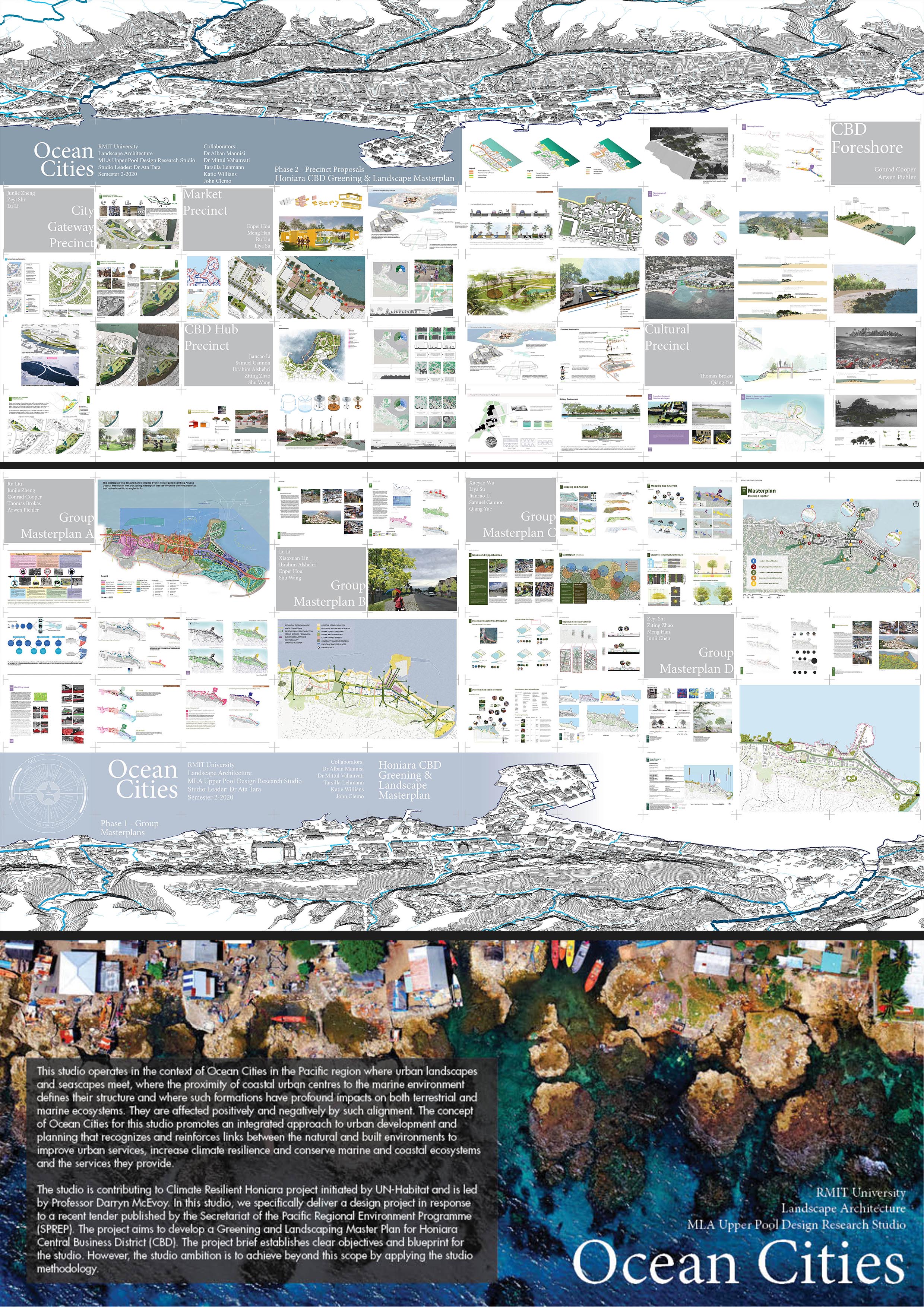14
NovemberRMIT Ocean Cities Studio
Ocean Cities Studio is an Upper Pool Design Studio (MLA-Semester 2-2020) offered by the Landscape Architecture Program at the School of Architecture of Urban Design RMIT University. This studio operated in the context of Ocean Cities in the Pacific region where urban landscapes and seascapes meet, where the proximity of coastal urban centres to the marine environment defines their structure and where such formations have profound impacts on both terrestrial and marine ecosystems. They are affected positively and negatively by such alignment. The concept of Ocean Cities for this studio promotes an integrated approach to urban development and planning that recognises and reinforces links between the nature and culture to improve urban services, increase climate resilience and conserve marine and coastal ecosystems and the services they provide.
Ocean cities are diverse, varying significantly in their composition of settlements and governance arrangements, services and capacities. The majority of these cities in Melanesia are rapidly urbanizing. The urban populations of Papua New Guinea, Solomon Islands and Vanuatu are expected to double in 25, 17 and 16 years, respectively (UN, 2019). The urban population increase is the result of the movement of migrant communities into urban and peri-urban areas from neighbouring islands. Furthermore, these cities are at the forefront of climate change consequences, urbanization challenges and other development pressures.
As a result, cities like Honiara, the capital of Solomon Islands face threats of environmental hazards as they grapple with the lack of adequate infrastructural services (UN, 2019). Furthermore, Honiara is at the forefront of climate change consequences, urbanization challenges and other development pressures and urban population growth as the result of the movement of migrant communities into urban and peri-urban areas from neighbouring islands. Inefficiencies of planning, infrastructure development, and services operations are carried out in an uncoordinated way which have worsened the situation. These conditions urged the studio to think beyond conventional norms of practice and provide helpful design for improvement of neglected public spaces, green infrastructure and basic condition of built and non-built environment (Rekittke, 2009).
The studio contributed to the Climate Resilient Honiara which is funded by the UNFCCC Adaptation Fund and administered by UN-Habitat. RMIT University, led by Prof. Darryn McEvoy, provide scientific support. In this studio, we specifically delivered a collective work in response to a recent tender published by the Secretariat of the Pacific Regional Environment Programme (SPREP). The studio was led in two phases in the group and individual modes. It started by master planning in four teams and followed by individual design proposals focused on five precincts identified in the first phase of the studio.
A summary of project brief advertised by SPREP:
“Urban growth remains fast and at current growth rates it is expected the population within the boundaries will increase from an estimated 87,000 in 2015 to 120,000 by 2030. As an urban environment, much of Honiara is comprised of the built features of its residential, commercial, and industrial precincts. Competing land use options for urban expansion, peri urban development, infrastructure expansion, and demand for housing must be balanced with the need to improve social services, public amenities, green spaces, and recreational areas. The Honiara Capital Business District is located from Mataniko River to Rove Stream.
To ensure better development and management of green spaces and recreational areas, a Honiara CBD Greening and Landscaping Master Plan will be developed in collaboration with the Honiara City Council (HCC) and the Ministry of Environment, Climate Change, Disaster Management and Meteorology (MECDM), Ministry of Forestry and Research and other ongoing initiatives to support the greening of Honiara city through rehabilitation of natural and built ecosystems. To that end SPREP requires the services of a suitably qualified local consultant to develop this master plan. Due to COVID-19 and the current uncertainty with travel arrangements, there will be no international travel.
The master plan will have a primary focus on the Honiara CBD and will consider options identified in the Ecosystem-based Adaptation: Options Assessment and Master Plan and related documents prepared by the Pacific Ecosystem-based Adaptation to Climate Change (PEBACC) project for Honiara.”

vreyrolinomit
December 18, 2020 at 4:20 amGood post. I study something tougher on totally different blogs everyday. It would always be stimulating to learn content from different writers and apply somewhat one thing from their store. I’d prefer to use some with the content material on my weblog whether you don’t mind. Natually I’ll provide you with a hyperlink in your internet blog. Thanks for sharing.
erotik
February 17, 2021 at 12:53 amFantastic web page you have in this article, i do agree on some matters though, but not all. Eimile Ingram Leann Elbertine Fredric Julian
Marissa
January 11, 2022 at 3:38 pmI am sure this post has touched all the internet users, its really
really nice piece of writing on building up new webpage.